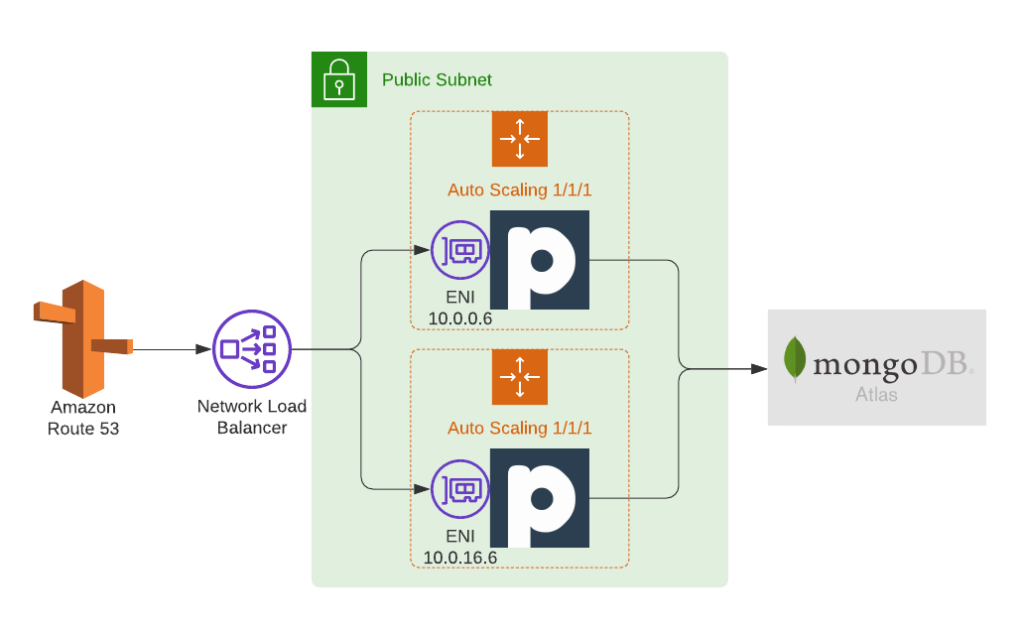
From OpenVPN to Pritunl VPN: The transition
Usually, organizations use an internal network to prevent unauthorized people from connecting to their private network. By using their own network infrastructure and connectivity, they can maintain their desirable level of security for their data.
But it would be convenient for users to connect to that private network while they are away from the office through their own internet connection. To solve that problem, a virtual private network (VPN) is used to allow authorized remote access to an organization’s private network.
Working in a fully remote company like Mattermost creates the need for employees to use a VPN connection in order to be able to access internal private infrastructure and resources. A vast majority of companies use OpenVPN as a solution to host those VPN connections on their own servers.
OpenVPN is a widely used software and protocol which was also our selection to be used as a quick and reliable solution to access our internal infrastructure. After using it a while, we needed a better solution in terms of:
- High availability (HA)
- Auditing
- Supporting better access control (e.g., only SREs can access production servers and only developers can access development accounts)
- Working with SSO, particularly OneLogin
After some investigation, we ended up with Pritunl because:
- It’s built on the OpenVPN protocol
- It’s open source
- The Pritunl client can be installed on any platform
- Its pricing is reasonable for our scale
- It hides the complete configuration (user and server management) overhead behind the scenes of the web interface
Pritunl infrastructure
To deploy Pritunl in our infrastructure, we used Terraform. The module we wrote can be found here as an example for how to deploy Pritunl. The infrastructure consists of:
- One Route 53 record
- One network load balancer
- Two AutoScaling Groups (ASGs)
- One MongoDB Atlas

Why two Auto Scaling groups?
The selection of two ASGs with one instance has been done due to the necessity of having the same Elastic Network Interface (ENI), which results on having the same private and public IPs. This is useful when whitelisting those IPs into the Security Groups that Pritunl-VPN needs to access internally, such as our internal GitLab instance.
This can be achieved by attaching those ENIs as a secondary network interfaces on the instance, as outlined in the appendix below.
You can manually create two ENIs (we selected the sixth address of each subnet 10.0.0.6 and 10.0.16.6) and attach public IPs to them. Then you can provide the list of the ENI IDs with the variable (list) fixed_eni on Terraform.
MongoDB Atlas
Initially, we checked the AWS DocumentDB solution. But it was quite expensive, as it starts at $0.28/hr for one db.r5.large instance. Next, we deployed two instances and installed and configured a MongoDB cluster, but maintaining and making sure that HA worked effectively was a big overhead.
Thus, we selected to use MongoDB Atlas as it is cheaper (starts from the free tier) and easier to set up. After the creation of the MongoDB Atlas, we added Pritunl’s public IPs on the whitelist of the Atlas cluster and we connected to the Atlas cluster locally to create a new database in it called pritunl (guide on how to connect). Also check Pritunl documentation for MongoDB Atlas.
To set up the MongoDB URI (mongodb+srv://pritunl:[email protected]/pritunl) use the variable (string) mongodb_uri on Terraform.
Network Load Balancer
The Network Load Balancer (NLB), which is in front of the instances, has five listeners as shown below. There are three listeners for VPN (on ports 1194, 1195, 1196) that can be used for the servers inside the Pritunl. Currently, we are using only port 1194, so the rest are for future usage.

Pritunl configuration
Pritunl is installed via the userdata. As the instances do not store any configuration items except the MongoDB URI, each instance needs to connect to the MongoDB to obtain the required configuration and then the instance joins the Pritunl cluster.
Initial setup
As per Pritunl documentation:
- SSH into one of the Pritunl instances by using Session Manager.
- Run
sudo pritunl default-passwordto get the default username and password. - Navigate to the Pritunl log in page and use the credentials from the previous step.
- Create a user pritunl and add a new password.
Organization and server setup
As per Pritunl documentation:
- Navigate to Users and create a new organization, e.g.,
devs_org - Navigate to Servers and create a new server:
- Name:
devs_server - Port:
1194(or any other port that you have setup for VPN access, check NLB) - DNS Server:
10.0.0.2, 8.8.8.8where10.0.0.2is the DNS resolution of the subnet. The second IP of each subnet is used for DNS resolution and our VPC where Pritunl is running has peering with all the other VPCs, so it is able to resolve all the names inside our network. - Save your changes.
- Name:
- Remove the
0.0.0.0/0route from thedevs_server. - Select Attach Organization to attach
devs_orgwithdevs_server. - Select Attach host to attach the two hosts (instances).
- Select Add Route (ensure that the server points to
devs_server).- You’ll need to add the DNS resolution as we have set it up above on the
DNS Server:- 10.0.0.2/32 DNS resolution
- You’ll need to add all the routes that this server will need to access (e.g., other VPCs) (add routes and each comment for clarity) e.g.:
- 10.8.0.0/16 prod VPC
- 10.16.0.0/16 staging VPC
- Wherever else you want the Pritunl/VPN to have access.
- You’ll need to add the DNS resolution as we have set it up above on the
- Start the server with
Start Serverbutton
Enabling OneLogin
To enable Onelogin, Pritunl Enterprise (with subscription) is needed. Otherwise, the configuration won’t display in the Settings. Then, you will need to set up a new app inside OneLogin (admin access is needed) and you will need to paste that information inside Pritunl:
- Single Sign-On:
OneLogin - OneLogin App ID:
1234567 - SAML Sign-On URL:
https://your-company.onelogin.com/trust/saml2/http-redirect/sso/xxxx-xxxx-xxxx-xxxx - SAML Issuer URL:
https://app.onelogin.com/saml/metadata/xxxx-xxxx-xxxx-xxxx - OneLogin API Client ID, OneLogin API Client Secret, and the SAML Certificate.
Appendix
Attach second ENI
Below is the Bash script to attach a second ENI for Ubuntu 18.04 as per AWS documentation.
That script can be used widely for other purposes, as well.
# ----- Add fixed Network Interface -----
printf "\n### Installing AWS CLI ###\n"
apt install awscli -y
printf "\n### Attaching ENI to instance ###\n"
INSTANCEID=$(curl https://169.254.169.254/latest/meta-data/instance-id)
MACS=$(curl https://169.254.169.254/latest/meta-data/network/interfaces/macs/ | head -n1)
SUBNETID=$(curl "https://169.254.169.254/latest/meta-data/network/interfaces/macs/$MACS/subnet-id")
NETWORKINTERFACEID=$(aws ec2 describe-network-interfaces --filters Name=tag:OnlyFor,Values=pritunl Name=status,Values=available Name=subnet-id,Values=$SUBNETID --query 'NetworkInterfaces[0].NetworkInterfaceId' --region us-east-1 --output text)
NETWORKINTERFACEIP=$(aws ec2 describe-network-interfaces --network-interface-ids $NETWORKINTERFACEID --region us-east-1 --query 'NetworkInterfaces[].[PrivateIpAddress]' --output text)
aws ec2 attach-network-interface --network-interface-id $NETWORKINTERFACEID --instance-id $INSTANCEID --device-index 1 --region us-east-1
printf "\n### Configuring instance to use secondary ENI ###\n"
SUFFIXDEFAULTIP=$(echo $NETWORKINTERFACEIP | sed 's/\.[^.]*$//')
cat <<EOF > /etc/netplan/51-eth1.yaml
network:
version: 2
renderer: networkd
ethernets:
eth1:
addresses:
- $NETWORKINTERFACEIP/20
dhcp4: no
routes:
- to: 0.0.0.0/0
via: $SUFFIXDEFAULTIP.1 # Default gateway
table: 1000
- to: $NETWORKINTERFACEIP
via: 0.0.0.0
scope: link
table: 1000
routing-policy:
- from: $NETWORKINTERFACEIP
table: 1000
EOF
netplan --debug apply
Pritunl API sample
In order to invoke the Pritunl API, we had to make some changes on the Python code that exists here as below:
import requests, time, uuid, hmac, hashlib, base64
BASE_URL = 'https://localhost'
API_TOKEN = 'p7g444S3IZ5wmFvmzWmx14qACXdzQ25b'
API_SECRET = 'OpS9fjxkPI3DclkdKDDr6mqYVd0DJh4i'
def auth_request(method, path, headers=None, data=None):
auth_timestamp = str(int(time.time()))
auth_nonce = uuid.uuid4().hex
auth_string = '&'.join([API_TOKEN, auth_timestamp, auth_nonce,
method.upper(), path])
auth_string_bytes = bytes(auth_string, 'utf-8')
api_secret_bytes = bytes(API_SECRET, 'utf-8')
auth_signature = base64.b64encode(hmac.new(
api_secret_bytes, auth_string_bytes, hashlib.sha256).digest())
auth_headers = {
'Auth-Token': API_TOKEN,
'Auth-Timestamp': auth_timestamp,
'Auth-Nonce': auth_nonce,
'Auth-Signature': auth_signature,
}
if headers:
auth_headers.update(headers)
return getattr(requests, method.lower())(
BASE_URL + path,
headers=auth_headers,
data=data,
)




